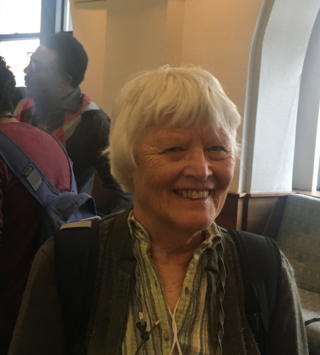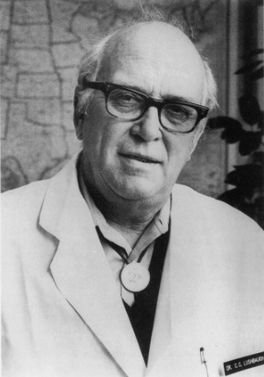Related Research Articles

Stanisław Marcin Ulam was a Polish mathematician, nuclear physicist and computer scientist. He participated in the Manhattan Project, originated the Teller–Ulam design of thermonuclear weapons, discovered the concept of the cellular automaton, invented the Monte Carlo method of computation, and suggested nuclear pulse propulsion. In pure and applied mathematics, he proved some theorems and proposed several conjectures.

Emilio Gino Segrè was an Italian and naturalized-American physicist and Nobel laureate, who discovered the elements technetium and astatine, and the antiproton, a subatomic antiparticle, for which he was awarded the Nobel Prize in Physics in 1959 along with Owen Chamberlain.

James Leslie Tuck was a British physicist.

Gertrude Mary Cox was an American statistician and founder of the department of Experimental Statistics at North Carolina State University. She was later appointed director of both the Institute of Statistics of the Consolidated University of North Carolina and the Statistics Research Division of North Carolina State University. Her most important and influential research dealt with experimental design; In 1950 she published the book Experimental Designs, on the subject with W. G. Cochran, which became the major reference work on the design of experiments for statisticians for years afterwards. In 1949 Cox became the first woman elected into the International Statistical Institute and in 1956 was President of the American Statistical Association.

Darleane Christian Hoffman is an American nuclear chemist who was among the researchers who confirmed the existence of seaborgium, element 106. She is a faculty senior scientist in the Nuclear Science Division of Lawrence Berkeley National Laboratory and a professor in the graduate school at UC Berkeley. In acknowledgment of her many achievements, Discover magazine recognized her in 2002 as one of the 50 most important women in science.

Herbert Lawrence Anderson was an American nuclear physicist who was Professor of Physics at the University of Chicago.

Harold Melvin Agnew was an American physicist, best known for having flown as a scientific observer on the Hiroshima bombing mission and, later, as the third director of the Los Alamos National Laboratory.

Nancy Flournoy is an American statistician. Her research in statistics concerns the design of experiments, and particularly the design of adaptive clinical trials; she is also known for her work on applications of statistics to bone marrow transplantation, and in particular on the graft-versus-tumor effect. She is Curators' Distinguished Professor Emeritus of Statistics at the University of Missouri.
Aparna V. Huzurbazar is an American statistician known for her work using graphical models to understand time-to-event data. She is the author of a book on this subject, Flowgraph Models for Multistate Time-to-Event Data.
Joanne Roth Wendelberger is an American statistician and a scientist at the Los Alamos National Laboratory.
Jane Elizabeth (Beth) Nordholt is an American physicist known for her work in space science on mass spectrometry of the solar wind and rings of Saturn and the flow of water vapor in the Earth's polar wind, and for her work in digital security on devices for quantum key distribution and random number generation. Until her retirement, she worked at Los Alamos National Laboratory, which in 2006 named her as a Laboratory Fellow.

Christine Michaela Anderson-Cook is a U.S. and Canadian statistician known for her work on the design of experiments, response surface methodology, reliability analysis in quality engineering, multiple objective optimization and decision-making, and the applications of statistics in nuclear forensics. She has published over 200 research articles in statistical, engineering and interdisciplinary journals. She also written on misunderstandings caused by "hidden jargon": technical terms in statistics that are difficult to distinguish from colloquial English.
Brenda Lynn Dingus is an American particle astrophysicist at the Los Alamos National Laboratory, known for her research on gamma-ray bursts and cosmic rays.
Dana Dattelbaum is an American physicist and scientist at Los Alamos National Laboratory. She leads NNSA’s Dynamic Materials Properties portfolio at LANL, which provides experimental data, platforms and diagnostics for materials behaviors relevant to nuclear weapons performance, ranging from plutonium to high explosives.

Clarence Chancelum Lushbaugh Jr. was an American physician and pathologist. He was considered an expert in radiological accidents and injuries, as well as a pioneer in radiation safety research, and he is known for his controversial research involving human subjects.
Irene Jane Beyerlein is an American materials scientist who is the Mehrabian Interdisciplinary Endowed Chair at the University of California, Santa Barbara. She is a Fellow of the Materials Research Society.
Carol Jean Burns is an American chemist who is deputy director of Research at Lawrence Berkeley National Laboratory. Her research is in actinide coordination and organometallic chemistry. She spent a term at the White House Office of Science and Technology Policy, and is a Fellow of the American Chemical Society. She was awarded the American Chemical Society Garvan–Olin Medal in 2021.
Melissa J. Moore is an American biochemist who focuses on RNA. She was the Chief Scientific Officer of Moderna from 2016-2023, where her team contributed to the development of the Moderna COVID-19 vaccine.

Nicole Marie Lloyd-Ronning is an American computational astrophysicist specializing in gamma-ray bursts and the deaths of massive stars as a researcher at the Los Alamos National Laboratory and lecturer at University of New Mexico–Los Alamos. She is also known for her work in science popularization, as the author of the book Great Mysteries in Astrophysics, as a scientist ambassador for the Bradbury Science Museum, and in youth outreach programs, especially for young people from indigenous groups in the American southwest.
Mary Yvonne Pottenger Hockaday is an American physicist who works at the Los Alamos National Laboratory. She was elected a Fellow of the American Association for the Advancement of Science in 2014 and the American Physical Society in 2022.
References
- 1 2 3 "Leslie Melissa Moore", Profile Pages, Los Alamos National Laboratory, retrieved November 15, 2017
- 1 2 3 4 5 "Leslie M. Moore Wins 2013 Don Owen Award", Amstat News, American Statistical Association, June 1, 2013
- ↑ ASA Fellows list, American Statistical Association, archived from the original on November 21, 2019, retrieved November 15, 2017